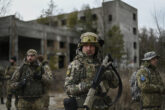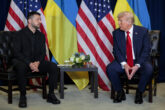May 09, 2022
Can Ukraine’s Military Keep Winning?
In 2014, when Russian forces entered the Crimean Peninsula, they faced remarkably little resistance. The Ukrainian military was weak, poorly trained, and corrupt. That was the Ukrainian military Russian President Vladimir Putin expected to encounter when he invaded the country again in February 2022. Assuming that the Ukrainian military would not put up much of a fight, Russia opted for a multipronged attack advancing from numerous locations in Russia, Belarus, and previously occupied Ukrainian territory. By the time it became clear that the multipronged invasion would not achieve the swift surrender that the Kremlin had expected, Russia’s forces were dispersed across a vast country and, in many cases, running critically short of supplies.
Ukraine’s military has undergone a radical transformation over the past eight years, thanks to intensive reorganization and reform efforts and billions of dollars in Western security assistance.
As Putin discovered, Ukraine’s military has undergone a radical transformation over the past eight years, thanks to intensive reorganization and reform efforts and billions of dollars in Western security assistance. In January 2022, the Congressional Research Service reported that the Ukrainian army had grown from about 6,000 combat-ready troops in 2014 to nearly 150,000 troops, a number that has been climbing higher since the Russian invasion, as Ukrainians from all walks of life have volunteered for military service.
The Ukrainian military has also vastly upgraded its equipment, thanks to a massive influx of Western military aid. Since 2014, the United States has provided more than $6.1 billion in security assistance to Kyiv, including more than $3.4 billion since the war began on February 24. In the weeks since the Russian invasion, the list of military equipment that Ukraine has received from the United States alone includes nearly 6,000 Javelin anti-armor systems, 1,400 Stinger missiles, 16 Mi-17 helicopters, and 90 155mm howitzer artillery systems, along with some 184,000 rounds of artillery.
Read the full article from Foreign Affairs.
More from CNAS
-
Transatlantic Security / Middle East Security
The Russia-Iran Partnership: A Geopolitical Balancing ActIt has been almost a year since Russia and Iran signed their comprehensive strategic partnership. That deal established a 20-year partnership between the two countries coverin...
By Andrea Kendall-Taylor & Jim Townsend
-
Defense / Transatlantic Security
Ukraine’s Catch-22 MomentThis article was originally published in the Financial Times. In Joseph Heller’s wartime classic, Catch-22, the protagonist Yossarian seeks out the US army surgeon Doc Daneeka...
By Franz-Stefan Gady
-
Transatlantic Security / Middle East Security / Energy, Economics & Security
Sanctions Aren’t Enough to Shut Down the Moscow-Tehran Black Market for WarThe geographic scope and extent of Iranian-Russian cooperation highlights the failure of traditional sanctions to prevent Moscow and Tehran from seeking key components like ch...
By Delaney Soliday
-
What’s Driving President Trump’s New Confidence in Ukraine’s War Effort
President Trump dramatically declared on social media that he now believes that Ukraine can reclaim all its land from Russia, which he described as a paper tiger. From the Ova...
By Richard Fontaine




